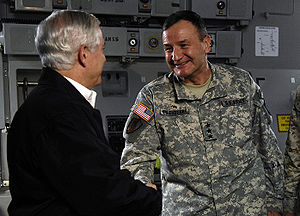 Image via WikipediaAnother one of those light-touch reports from our friendly SIGAR office.
Image via WikipediaAnother one of those light-touch reports from our friendly SIGAR office.
SIGAR has just released its 36-page audit on the civilian surge in Afghanistan -- U.S. Civilian Uplift in Afghanistan is Progressing but Some Key Issues Merit Further Examination as Implementation Continues (SIGAR-Audit-11-2 | October 26, 2010 | 36 pages). We were was going to republish the document here for easy reading but the report is in a restrictive PDF format that made it, at least for now, unpublishable in ScribD. Below is an excerpt from the press statement:
The SIGAR audit shows the "civilian surge" is being implemented in two phases and will take U.S. government civilian capacity from 320 civilians in January 2009 to approximately 1500 civilian employees by January 2012. Additionally, the audit finds that U.S. agencies have deployed nearly 67% of the civilian personnel for this "surge".
While auditors found that housing and operational needs have generally been met across the field locations, there are issues in civil-military integration and coordination. Civilian and military officials report that there are challenges in developing the integrated working relationship, stemming from differences in organizational cultures and perspectives.
Additionally, civilians have told SIGAR auditors there is a lack of clarity from their agencies on various aspects of their work in the field, including position roles and responsibilities; reporting and supervisory relationships within the field structure; and the role of the Office of Interagency Provincial Affairs as it applies to work at the field locations.
Civilians involved in the "surge" report receiving limited information on their roles and responsibilities before arriving at their assigned locations. They also cited lack of information on national development programs that are being implemented in their areas of operation. SIGAR auditors report when civilians cannot provide quick responses to their military counterparts, they are viewed as being ineffective, which can strain efforts at civilian-military integration. This lack of information is also deemed to compromise effectiveness on program oversight, according to the report.
[...]
The SIGAR report provides two recommendations to ensure that the interagency review of the civilian uplift is comprehensive. In particular, SIGAR recommended that the U.S. Ambassador to Afghanistan develop a mechanism for collecting, analyzing, and applying lessons learned and best practices, to include the design and implementation of a series of comprehensive field surveys.
Read the whole report here.
First, we have to say that putting restrictions on a USG government is not unheard of, but disabling the copy and paste function is not nice SIGAR people! Even the GAO doesn't do that to their reports, and they have been around longer than you guys. Not only that, SIGAR has also "encrypted" all contents of the document so search engines will not have access to this document's metadata. We should be grateful that we can at least print and read this "public" document, huh?
Second, read the report's recommendation closely. Is it just us or does it come across like whoever wrote this report seem quite detached from the reality of a 24/7 operation of a US mission in a warzone? Where are these folks coming from? Must the "U.S. Ambassador to Afghanistan develop a mechanism for collecting, analyzing, and applying lessons learned and best practices, to include the design and implementation of a series of comprehensive field surveys?" Holy mountain goat -- field surveys??? We fell off our chair when we read those recommendations. We quite understand the need for lessons learned and best practices, field surveys and all that -- really -- but dude, do you have to give that job to that poor man in Kabul who already has to deal with looniness in Afghanistan and Wash DC, work even on his one off day of the week, tele/video conference during ungodly hours, and play guide to war tourists and VIPs, in addition to running the US mission?
Wouldn't it make more sense to have the data collected at the conclusion of the Afghanistan assignment back at the big house during an outbrief -- either at S/CRS, or at the Af/Pak "bureau" or whichever alphabet soup is responsible for the inbrief of all employees heading to Afghanistan? The office responsible for the inbrief of all civilians hearing over there could also be responsible for the outbrief of civilians coming home, regardless of their home agency, and the responsible office then ought to get face time with FSI and other training arms to improve the deployment preparation of civilians.
Also, just wondering -- where's the recommendation on how to address the challenges in "civil-military integration and coordination?" How many of the nearly 67% deployed civilian did SIGAR talked to? For instance, there are 35 DSTs in the country, and SIGAR talked to 4 during their June/July field visits.
It's a good thing this report is free; we would have asked for our money back had we paid for it.
Um wait -- we did pay for this; that's our tax dollars at work! Aaaaahhhhrggggg!



No comments:
Post a Comment